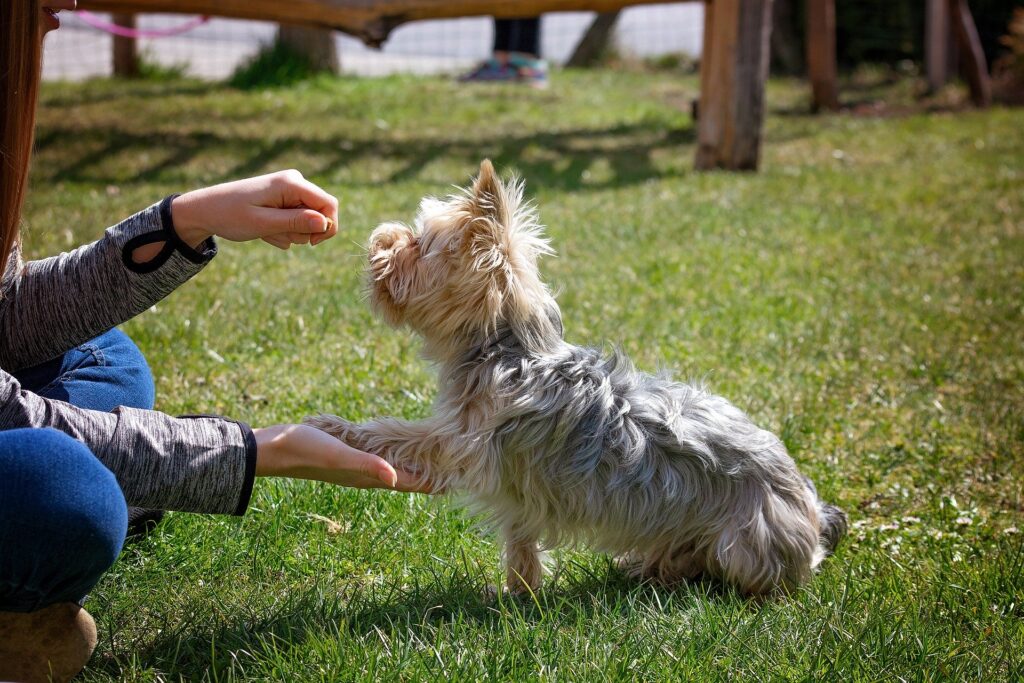



This post is part of a continuing series on preparing your pet for therapy animal work.

Animals who become part of our Therapy Animal Program need some essential skills in order to do this work safely and successfully. While the skills will vary depending on the animal’s species, all prospective therapy animals will need some training to ensure that they—and you, as the handler guiding them—can achieve the skills needed. But it’s not only prospective therapy animals who can benefit from training, and particularly positive training methods.
Whether you’re training your cat in skills they’ll need to become a therapy animal, enjoy having your bird show off some fun tricks, or simply want your dog to stop stealing your dirty socks, positive training methods are the way to go. Learn about what positive training is, why punishments don’t work, and how we at Pet Partners make sure that animal welfare during training is a top priority.
A lot of the information in this article is from Pamela Dennison’s book, You Can Train Your Dog: Mastering the Art & Science of Modern Dog Training. This book is highly recommended in the therapy animal training world, using humor and experience to explain positive training. While it refers to dogs, the same principles can work with our other eligible species, too!
Positive training is any type of training that positively reinforces behaviors that you want out of your animal, while ignoring those less-than-ideal behaviors (you know the ones). Not only does this build a trusting relationship between you and your animal, but it is more effective than punishment-based training because it addresses the root of the problem (anxiety, fear, boredom) rather than just punishing the symptom (aggression, having accidents, chewing).
Dennison points out that positive training requires more work on the human end of the leash, because it’s easier to yell or punish than it is to take a step back, ignore negative behavior, and reinforce positive behavior. However, it’s worth the extra time and effort. Positive training is easier on the animal, builds trust and communication, and leads to happier lives for animals and their handlers. That’s why it’s recommended by not only Pet Partners, but other leaders in the animal world such as the Humane Society of the U.S. and the American Veterinary Medical Association.

When you hear the word “punishment,” you probably think about hitting, spanking, and shock collars. But did you know that yelling at your animal or jerking their leash is also considered a punishment? Anything that is meant to stop a behavior in a negative way is considered a punishment, and punishments don’t eliminate bad behaviors—they may suppress those behaviors momentarily, but with time the behaviors will escalate.
Dennison explains that punishment doesn’t work because it confuses the animal and exacerbates the symptoms without solving the root of the problem:
“More often than not, it’s our reactions or punishment that create worse problems than what we started with. What may have started out as mild anxiety can quickly grow into full-blown fear and avoidance.”
Her idea is supported by this scenario:
“When I come across a dog who growls at me, I get down and kiss his feet (well, not literally) and thank him for warning me. Punish the dog for giving off a warning and guess what? You won’t get warnings anymore—you’ll just get a bite.”
A momentary break from an undesirable behavior is not worth the effects of punishment: anxiety, fear, avoidance, escaping, and aggression. With continued punishment, your animal may shut down and stop responding completely, because they have learned that no matter what they do, it’s never right and they will likely be punished regardless.
Here’s an example: you have a dog that barks every time children run by. This dog perceives these children as a threat and has been reinforced to bark when kids run by without us even knowing it. How, you ask? Check out this doggie logic:
Every time kids run past me, I bark. Every time I bark, they eventually disappear!
So how do we get the dog to stop barking as children run by? Instead of punishing the dog for this undesirable behavior, Dennison describes how you can positively reinforce the dog for NOT performing that behavior:
[i]“If he barks at kids running, enlist the neighborhood kids to help you. Have them walk by slowly, reinforcing your dog for not barking. Then have them slowly jog by, then run by, and then maybe even add that ear-piercing scream that most kids know how to do, all the while reinforcing your dog for quiet behaviors.”

By reinforcing the behavior you want instead (using treats, verbal or clicker praise, or affection), the beauty of positive training is highlighted. Using this method, you achieve several things:
This method can be applied to all scenarios. Identify the negative behavior your animal is currently trained to do and ignore that behavior. Then decide what behavior you want your animal to perform instead, and positively reinforce that behavior. It requires more thought and care than punishment-based training, but the effects are worth it and the benefits are long-lasting.
Pet Partners requires that animals that participate in our Therapy Animal Program are trained without the use of force-based techniques, as shown by our Standards of Practice.
Additionally, handlers who are seen kicking, striking, or otherwise roughly handling their animals during a team evaluation or on the testing grounds will be scored Not Appropriate for visiting, and will not be allowed to re-evaluate or register with our Therapy Animal Program.
Our focus on positive training techniques highlights our commitment to animal welfare. The Pet Partners Therapy Animal Program would not be able to function without healthy and happy therapy animals. While positive training may seem like a big commitment, it’s a commitment that is truly worth the effort.
To learn how to train animals to perform specific tasks that will be present on Pet Partners team evaluation skills checklist, understand the myths surrounding positive training, incorporating training into your life, and more, check out Pamela Dennison’s book.
Learn more about what is required for a Pet Partners registered therapy animal team.
Check out this helpful visual resource outlining the differences between positive training and traditional (punishment-based) training.
[i] Dennison, P. (2015). You Can Train Your Dog: Mastering the Art & Science of Modern Dog Training. Blairstown, New Jersey: Shadow Publishing.